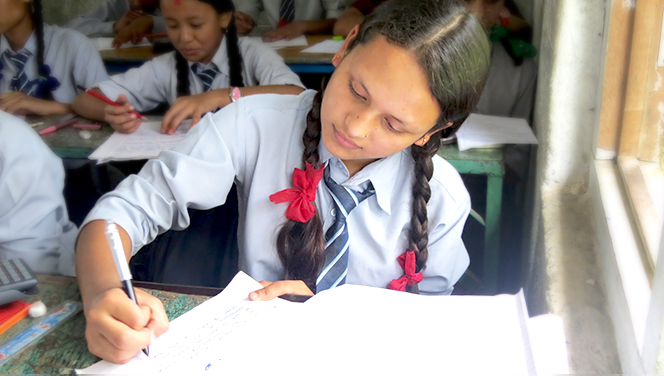Merging design thinking, human-centered design, and software design concepts with community service and outreach, Cal State LA Information Systems students helped to create sustainable programs and projects that solve real-world problems. By collaborating with Rukmini Foundation and the graduate mentors, the student teams refined their design ideas in developing prototypes. Some of the prototypes are already adopted by the foundation. One of the project groups recalled, “A project that teaches life lessons, skill building and networking is greater and richer than any other project. It is an opportunity to become better humans and confident professionals.”
The project was supported by mentors Maria Espinoza, Luis Barrier, Dalya Mantova, Kay Mack, and Mayur Patil. Many members such as Usha Adhikari, Usha Poudel, Apsara Adhikari, Bibhuti Aryal of the foundation also were actively involved in creating an experiential learning environment. As universities seek to transform education beyond the classroom towards a global community for positive societal impact, we hope to see more projects like these in the future.

Why Experiential Learning?
Experiential learning is also known as learning-by-doing. There are two main reasons why I prefer this method. First, I cannot see a scenario where a child wakes early in the morning, looking towards the day ahead, and thinks, “I would really like to go to school to memorize facts. It would be great to be locked in the room for hours and stare at the board or head down to the books.” The second reason has to do with my own schooling. I am deliberately using the word schooling as opposed to education.

I was not a “good student” by Nepali education standards. Well, actually, I peaked at the 2nd grade, where I was the first in my class, then steadily went downhill from there. Being first in the class had its privilege; for example, you were the “roll number 1”. Whenever teachers shouted “roll number 1,” you got to say “present” or “yes sir (or yes ma’am).” Even as a child, I was bewildered by these absurdities.
Transforming from a student hiding in the back row (also known as backbenchers) to being a professor in one of the largest university systems in the world was quite a journey that required me to reflect on the role of education. I support the ideas that education should help people develop their natural talents and abilities and help them make their way in the world around them. However, the typical school curriculum does not allow students the freedom to pursue what interests them at their individualized speed. Even though research findings from educational psychologists suggest that student curiosity and an appropriate level of challenge are critical drivers in the learning process.[1]
What do the students do in the classroom?
I teach Information Systems, which is an applied discipline. I adhere to saying, “not many cares about what you know, but most care about what you do.” Instead of telling me what you know, show me what you can do. So the students develop a functional prototype that solves a real-world problem in my Information Systems course. This past semester, the students worked with the foundation to create some prototypes to solve targeted to our scholars specifically and foundation generally.
Example Projects:
Project 1:

The Rukmini Foundation’s project is known as DEEP, and its four main goals were 1) to provide chrome books to over 500 girls, 2) handle logistics of getting the laptops to the students, 3) target the public schools that are already working with the foundation, and 4) provide guidance to the schools on remote education.
Problem: How to provide online-based learning to students in remote regions of Nepal with limited internet access?
Solution: Create online Moodle Lesson Plans where students can log in, access, and submit classwork. Teachers can log in, upload lesson plans, and grade the students’ work all in the same location.
We developed the Moodle classroom with the lesson plans preloaded on the platform for the curriculum to be available offline.
Full write up: https://medium.com/edustars/rukmini-online-learning-management-system-fa6aa3d0a0b4
Project 2:
Problem: How can we provide a non-traditional engaging education to young girls when their daily lifestyle is rushed with multiple, time-consuming tasks?

Solution: Introduce a whole new perception towards time.
While maintaining a schedule, a good/smart roster will ensure that a girl child will be able to invest some time in the activities she enjoys doing while also learning the importance of how a simple alternate household chores shift would carry in breaking the monotony. Also, introducing a cooking device like an instapot that is energy efficient and easy to clean equipment will help save their overall cooking time by approximately 33%. Introducing a small storage tank could suffice a family’s daily water needs for a minimum of 2 consecutive days. This in turn will reduce their daily effort of 2 hours for fetching water and would save time approximately by 8% during the day.
Full write up: https://sway.office.com/TdwHrm6EgwD2tOx5?ref=Link&loc=play
The remaining projects and details of this collaborations, I will write in future blog articles.
Last thoughts
We have experienced the success of Rukmini Foundation over the years not because it is a charitable foundation (although we are that), but it is engaged in community building. The success is result of our innovative, passionate, and collaborative. If success of an organization is an engaging process, shouldn’t education follow that model?
- A Program Tailor Made for Empowerment - April 29, 2023
- Doomed Fate or Powerful Architect of Our Society - March 31, 2022
- A classroom without walls, a school beyond borders - February 27, 2022
- Foundation Faces an Exam and Sees an Opportunity - June 29, 2019
- A Grand Mother’s Day - May 30, 2019

